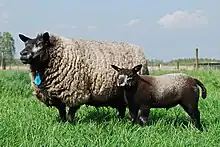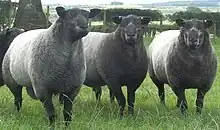Blue Texel
The Blue Texel, Dutch: Blauwe Texelaar, is a Dutch breed or strain of meat sheep. It is a colour variety of the Texel, which originates on the island of Texel in the Wadden Sea. A flock-book for blue sheep within the Texel breed was started in 1983, and a breed society was formed in that year.
 An ewe with her lamb | |
| Conservation status | |
|---|---|
| Other names | Blauwe Texelaar |
| Country of origin | Netherlands |
| Use | meat |
| Traits | |
| Weight | |
| Height | |
| Wool colour | blue |
| |

History
The Texel originates on the island of Texel in the Wadden Sea. Blue-woolled lambs were sometimes born in Texel flocks, but little attention was paid to them until the 1970s, when deliberate breeding for blue colour began, and some blue flocks were established.[4]: 765 A flock-book for blue sheep within the Texel breed was started in 1983, and a breed society was formed in that year.[4]: 765 [2]
By 2008–2009 numbers had risen to about 6500 head; in 2021 the total population was estimated at about 4000, with 2545 registered breeding ewes.[2] Its conservation status was listed by the FAO as 'not at risk' in 2007; in 2023 it was listed in DAD-IS as 'endangered/at risk'.[2]
Outside Holland, the Blue Texel is reported by Belgium and Germany;[3] it has also been exported to the United Kingdom.[5]
Characteristics
- Head should be narrow with a white halter mark
- Flat poll with no wool and head covered in fine hair with white tips on the ears
- Medium-sized sheep with a well-muscled body
- Fleece must be dense
- They should stand square and balanced
- Ideal color is a darker head and shoulder, light blue color on the back, and dark again around their back end.
- Black fleece with little or no white markings is not acceptable[5]
Use
Blue Texels are typically used as a terminal sire in commercial flocks to add muscle and other meat characteristics to the lambs. Their fleeces are also becoming more popular due to their unique colour pattern. Blue Texels are a new breed in the show ring and often catch the eye of the judge.[5]
See also
References
- Barbara Rischkowsky, Dafydd Pilling (editors) (2007). List of breeds documented in the Global Databank for Animal Genetic Resources, annex to The State of the World's Animal Genetic Resources for Food and Agriculture. Rome: Commission on Genetic Resources for Food and Agriculture, Food and Agriculture Organization of the United Nations. ISBN 9789251057629. Archived 23 June 2020.
- Breed data sheet: Blauwe Texelaar / Netherlands (Kingdom of the) (Sheep). Domestic Animal Diversity Information System of the Food and Agriculture Organization of the United Nations. Accessed July 2023.
- Transboundary breed: Blue Texel. Domestic Animal Diversity Information System of the Food and Agriculture Organization of the United Nations. Accessed April 2022.
- Valerie Porter, Lawrence Alderson, Stephen J.G. Hall, D. Phillip Sponenberg (2016). Mason's World Encyclopedia of Livestock Breeds and Breeding (sixth edition). Wallingford: CABI. ISBN 9781780647944.
- Cunnane, Catherina (2015-10-21). "All you need to know about Blue Texel Sheep | THATSFARMING.COM". That's Farming. Archived from the original on October 1, 2018. Retrieved 2017-04-03.